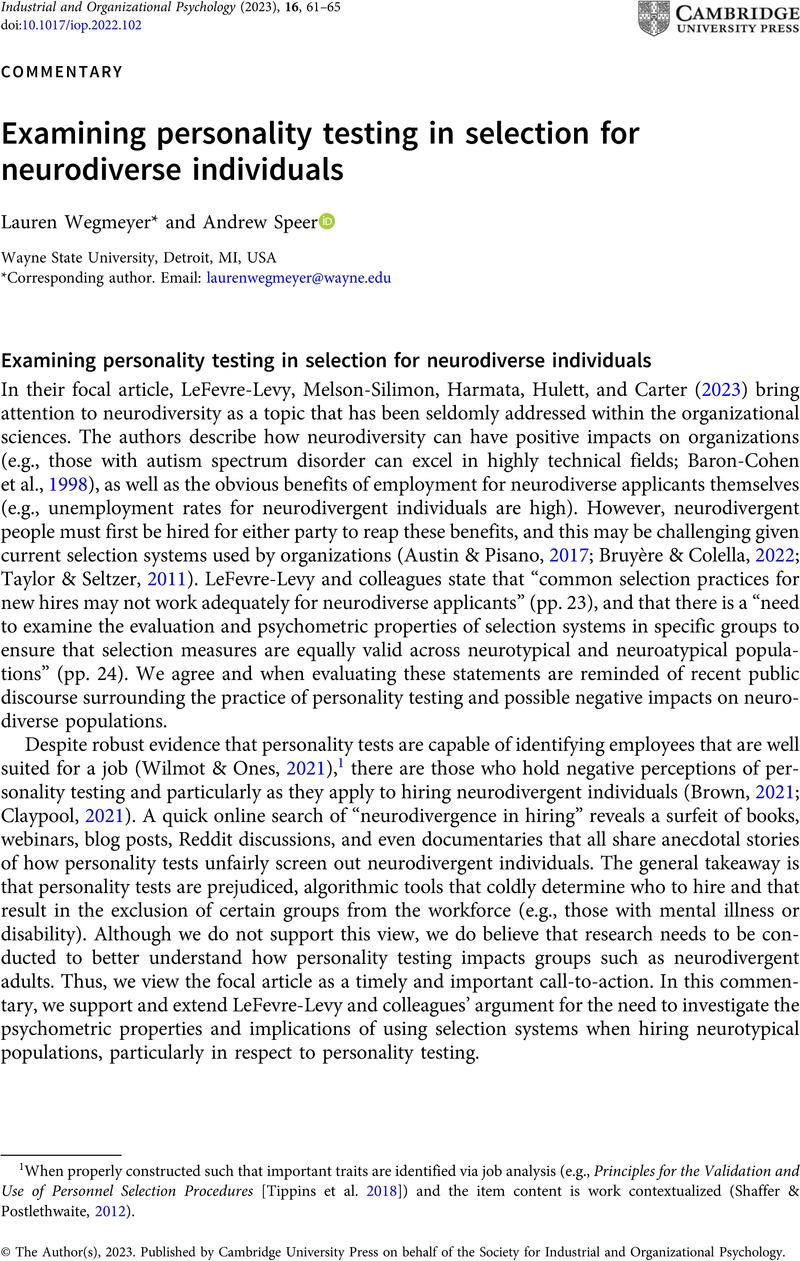No CrossRef data available.
Article contents
Examining personality testing in selection for neurodiverse individuals
Published online by Cambridge University Press: 09 March 2023
Abstract
An abstract is not available for this content so a preview has been provided. Please use the Get access link above for information on how to access this content.

- Type
- Commentaries
- Information
- Copyright
- © The Author(s), 2023. Published by Cambridge University Press on behalf of the Society for Industrial and Organizational Psychology
References
American Psychiatric Association. (2013). Diagnostic and statistical manual of mental disorders, 5th ed. American Psychiatric Publishing.Google Scholar
Austin, R. D., & Pisano, G. P. (2017, July 18). Neurodiversity is a competitive advantage. Harvard Business Review. https://hbr.org/2017/05/neurodiversity-as-a-competitive-advantage.Google Scholar
Baez, H. B. (2013). Personality tests in employment selection: Use with caution. Cornell HR Review. https://ecommons.cornell.edu/handle/1813/72937.Google Scholar
Baron-Cohen, S., Bolton, P., Wheelwright, S., Scahill, V., Short, L., Mead, G., & Smith, A. (1998). Does autism occur more often in families of physicists, engineers, and mathematicians? Autism, 2(3), 296–30.CrossRefGoogle Scholar
Bellini, S., & Peters, J. K. (2008). Social skills training for youth with autism spectrum disorders. Child and Adolescent Psychiatric Clinics of North America, 17(4), 857–873.CrossRefGoogle ScholarPubMed
Brown, L. (2021, January 6). How opaque personality tests can stop disabled people from getting hired. Center for Democracy & Technology. https://cdt.org/insights/how-opaque-personality-tests-can-stop-disabled-people-from-getting-hired/.Google Scholar
Bruyère, S. M., & Colella, A. (2022). Neurodiversity in the workplace: Interests, issues, and opportunities. SIOP Organizational Frontiers Series. Routledge.CrossRefGoogle Scholar
Chen, J. L., Leader, G., Sung, C., & Leahy, M. (2015). Trends in employment for individuals with autism spectrum disorder: A review of the research literature. Review Journal of Autism and Developmental Disorders, 2(2), 115–127.CrossRefGoogle Scholar
Chen, M. H., Wei, H. T., Chen, L. C., Su, T. P., Bai, Y. M., Hsu, J. W., Huang, K.-L., Chang, W.-H., Chen, T.-J., &
Chen, Y. S. (2015). Autistic spectrum disorder, attention deficit hyperactivity disorder, and psychiatric comorbidities: A nationwide study. Research in Autism Spectrum Disorders, 10(1), 1–6.CrossRefGoogle Scholar
Claypool, H. (2021, May 4). Job hiring increasingly relies on personality tests, but that can bar people with disabilities. NBC News: Health & Technology. https://www.nbcnews.com/think/opinion/job-hiring-increasingly-relies-personality-tests-they-can-bar-people-ncna1259466.Google Scholar
Cleary, T. A. (1968). Test bias: Prediction of grades of negro and white students in integrated colleges. Journal of Educational Measurement, 5(2), 115–124.Google Scholar
Fisher, D. M., Cunningham, S., Kerr, A. J., & Allscheid, S. P. (2017). Contextualized personality measures in employee selection: Extending frame-of-reference research with job applicant samples. International Journal of Selection and Assessment, 25(1), 18–35.CrossRefGoogle Scholar
Grob, C. M., Lerman, D. C., Langlinais, C. A., & Villante, N. K. (2019). Assessing and teaching job-related social skills to adults with autism spectrum disorder. Journal of Applied Behavior Analysis, 52(1), 150–172.Google ScholarPubMed
Heggestad, E. D., & Gordon, H. L. (2008). An argument for context-specific personality assessments. Industrial and Organizational Psychology: Perspectives on Science and Practice, 1, 320–322.CrossRefGoogle Scholar
Holtz, B. C., Ployhart, R. E., & Dominguez, A. (2005). Testing the rules of justice: The effects of frame-of-reference and pre-test validity information on personality test responses and test perceptions. International Journal of Selection and Assessment, 13(1), 75–86.CrossRefGoogle Scholar
LeFevre-Levy, R., Melson-Silimon, A., Harmata, R., Hulett, A. L., & Carter, N. T. (2023). Neurodiversity in the workplace: Considering neuroatypicality as a form of diversity. Industrial and Organizational Psychology: Perspectives on Science and Practice, 16.Google Scholar
Lodi-Smith, J., Rodgers, J. D., Cunningham, S. A., Lopata, C., & Thomeer, M. L. (2019). Meta-analysis of Big Five personality traits in autism spectrum disorder. Autism, 23(3), 556–565.CrossRefGoogle ScholarPubMed
Meade, A. W., & Tonidandel, S. (2010). Not seeing clearly with Cleary: What test bias analyses do and do not tell us. Industrial and Organizational Psychology: Perspectives on Science and Practice, 3, 192–205.Google Scholar
Murphy, K. R., & Jacobs, R. R. (2012). Using effect size measures to reform the determination of adverse impact in equal employment litigation. Psychology, Public Policy, and Law, 18(3), 477–499.CrossRefGoogle Scholar
Patton, E. (2019). Autism, attributions and accommodations: Overcoming barriers and integrating a neurodiverse workforce. Personnel Review, 48(4), 915–934.CrossRefGoogle Scholar
Ployhart, R. E., Ziegert, J. C., & McFarland, L. A. (2003). Understanding racial differences on cognitive ability tests in selection contexts: An integration of stereotype threat and applicant reactions research. Human Performance, 16(3), 231–259.CrossRefGoogle Scholar
Schriber, R. A., Robins, R. W., & Solomon, M. (2014). Personality and self-insight in individuals with autism spectrum disorder. Journal of Personality and Social Psychology, 106(1), 112.CrossRefGoogle ScholarPubMed
Shaffer, J. A., & Postlethwaite, B. E. (2012). A matter of context: A meta-analytic investigation of the relative validity of contextualized and noncontextualized personality measures. Personnel Psychology, 65(3), 445–494.CrossRefGoogle Scholar
Taylor, J. L., & Seltzer, M. M. (2011). Employment and post-secondary educational activities for young adults with autism spectrum disorders during the transition to adulthood. Journal of Autism and Developmental Disorders, 41(1), 566–574.Google ScholarPubMed
Tippins, N., Sackett, P., & Oswald, F. (2018). Principles for the validation and use of personnel selection procedures. Industrial and Organizational Psychology: Perspectives on Science and Practice, 11, 1–97.Google Scholar
Wakabayashi, A., Baron-Cohen, S., Wheelwright, S., Goldenfeld, N., Delaney, J., Fine, D., Smith, R., & Weil, L. (2006). Development of short forms of the Empathy Quotient (EQ-Short) and the Systemizing Quotient (SQ-Short). Personality and Individual Differences, 41(5), 929–940.CrossRefGoogle Scholar
Webb, B. J., Miller, S. P., Pierce, T. B., Strawser, S., & Jones, W. P. (2004). Effects of social skill instruction for high-functioning adolescents with autism spectrum disorders. Focus on Autism and Other Developmental Disabilities, 19(1), 53–62.CrossRefGoogle Scholar
Weiss, M. J., & Harris, S. L. (2001). Teaching social skills to people with autism. Behavior Modification, 25(5), 785–802.Google ScholarPubMed
Wilmot, M. P., & Ones, D. S. (2021). Occupational characteristics moderate personality–performance relations in major occupational groups. Journal of Vocational Behavior, 131(103655), 2–18.CrossRefGoogle Scholar




